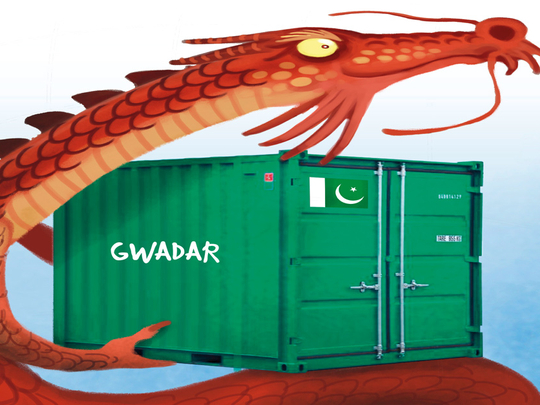
Pakistan’s deep-sea port Gwadar, which the Chinese built and are now operating under a 40-year agreement, remains a subject of considerable interest for much of the world. The port, 605km east of the world’s biggest energy choke point — Straits of Hormuz, has a much bigger strategic dimension than earlier imagined. Nearly 20 per cent of the world’s traded oil and 77 per cent headed towards Asia-Pacific pass through the Straits everyday. Pakistan’s former president General Pervez Musharraf had described Gwadar as the “economic funnel for the whole region”. Gwadar shortens China’s route to the world by thousands of kilometres.
Gwadar’s importance increased manifold following China’s announcement of China-Pakistan Economic Corridor (CPEC) by President Xi Jinping in 2015 at an estimated cost of $45 billion (Dh165.51 billion). Additional projects have now raised the investment volume to $54 billion. As the southern terminal of the CPEC, close to the Straits of Hormuz, Gwadar assumes formidable importance in the high-stakes power game for strategic control of the Indian Ocean region.
Despite initial challenges, there is considerable optimism in its future because firstly the Chinese go full-steam once they take on a project. Secondly, Gwadar being a vital cog in the CPEC, China or Pakistan cannot afford its failure. The projected development of road, rail links, with oil and gas pipelines will convert Gwadar into a trans-shipment port for China and the Central Asian region.
Unconfirmed reports indicate that after senior Russian officials visited Gwadar, Pakistan has also acquiesced to Russia’s interest in using the port. Moscow’s gradual thaw towards Pakistan may also be a consequence of this mutual interest.
For Pakistan, Gwadar, with its industrial free zone is potentially the economic engine that can help shore up its faltering economy. The 923 hectares zone will be manufacturing hinterland for the Gwadar Port and will benefit countries of South Asia, Central Asia and the Middle East. Gwadar’s location 460km west of Karachi decreases Pakistan’s vulnerability against India in case of another round of hostilities between the two neighbours. Along with the naval base at Ormara 349km west of Karachi, Pakistan will have an enhanced ability to eavesdrop on India’s naval manoeuvres in the Arabian Sea.
Underlying China’s need is the fact the Gulf Cooperation Council (GCC) countries together account for 60 per cent of China’s energy supplies. Nearly 75 per cent of China’s energy supplies pass through the Straits of Malacca. The US navy and its allies have a commanding presence in both the regions and can block China’s supplies. Beijing for now seems to be developing Gwadar to be a terminal of Iranian, GCC and African oil, which leaves open the possibility of Chinese naval units patrolling the areas around. While this may be the ostensible interest, it is likely that Iran’s gas and oil pipelines will extend to Gwadar through overland route to provide greater security to its supplies from the Gulf.
Gwadar’s importance to CPEC is logical — once developed, it will help spur economic growth in China’s western region through much shorter energy supply route and for exports from China through Gwadar into the Middle East and beyond.
Gwadar’s strategic significance is best understood as part of a growing Chinese acquisition of port facilities, often described as the “string of pearls” in the Indian Ocean region. Gwadar followed Chinese presence in Myanmar, Bangladesh, Seychelles and Sri Lanka, and will soon add Djibouti where a Chinese-built naval base is nearing completion.
The US and India are just about the only significant countries looking at the Chinese OBOR/CPEC initiative with scepticism. They believe that the twin initiative is meant more to secure China’s geo-strategic aims with political and security implications for them. Gwadar is therefore, viewed differently by either side.
Despite several Chinese overtures to join the CPEC, India believes that the initiative, of which Gwadar is a key component, is designed for strategic encirclement of India. The US is also wary of China supplanting American hegemony around the world.
In this game of power, the fact remains that the US, through its land and sea-based deployments, overwhelmingly dominates the oil-producing Middle East region and the sea lanes. No rapidly ascending power can accept to remain a hostage to such military dominance. Hence the Chinese attempts to break out of the US-imposed order.
Gwadar and the CPEC project offer several opportunities to the GCC countries. From nearly 15,000km distance between the UAE ports to Xingjiang in China, the Gwadar route will bring the shipping distance down to just about 2,500km. When the road, rail and energy pipelines are in place, Gwadar will offer the shortest and more secure route for the transportation of Gulf oil to China and goods either way, eliminating any danger of chocking at Malacca.
Gwadar therefore, offers a unique opportunity for not only China and Pakistan, but will also directly benefit countries in Central Asia and the Middle East. The unhindered and efficient flow of energy and goods will bring advantages of interdependence leading to peace and greater prosperity to the region.
Sajjad Ashraf is an adjunct professor at the Lee Kuan Yew School of Public Policy, National University of Singapore. He was a member of Pakistan Foreign Service from 1973-2008.










